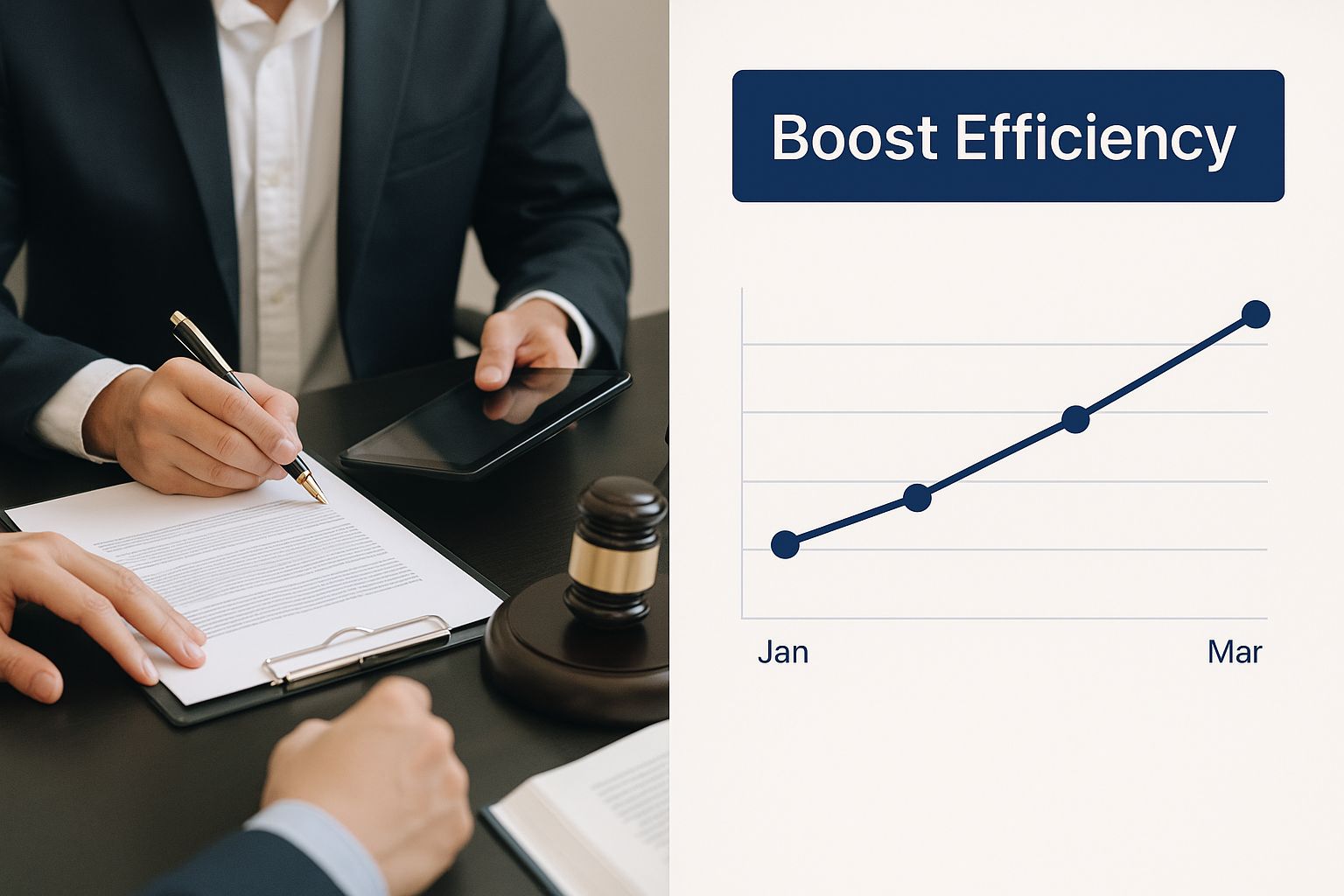Legal Workflow Automation: Boost Law Practice Efficiency
The Evolution of Legal Workflow Automation

The legal profession has undergone a dramatic shift. Gone are the days of overwhelming paperwork and time-consuming manual processes. While traditional methods often led to inefficiencies and increased overhead, legal workflow automation is reshaping how legal work gets done.
From Manual Processes to Automated Systems
Early legal automation centered on simple tasks like document assembly. Using software to automatically populate templates with client and case information was a major improvement over manual drafting. This initial phase set the stage for more sophisticated systems. For instance, basic automation could generate standard contracts or wills, allowing lawyers to dedicate their time to more complex legal issues.
Market forces have also significantly contributed to the rise of legal workflow automation. Law firms face growing pressure to boost efficiency, reduce costs, and deliver better client service, fueling the demand for automated solutions. Client expectations have evolved as well, with many now expecting faster turnaround times and greater transparency. For modern law firms, automation is no longer optional but essential for staying competitive. Read more about this on WhisperIt's blog: How to master document workflow automation.
The Rise of AI and Advanced Automation
Advancements in artificial intelligence (AI) have further accelerated the evolution of legal workflow automation. AI-powered systems can now manage intricate tasks like legal research, contract analysis, and e-discovery. These systems can process vast amounts of data, pinpoint key information, and even predict legal outcomes with increasing accuracy. The global robotic process automation market in legal services is poised for substantial growth, projected to reach USD 13.09 billion by 2034 from USD 3.15 billion in 2025, representing a 17.14% annual growth rate. This expansion is driven by the need to simplify tasks like document review and ensure compliance. Precendence Research provides more detailed statistics.
Technological Milestones
Several key technological advancements have made legal workflow automation more accessible and powerful. Cloud-based platforms allow firms of all sizes to adopt these solutions without significant upfront investment in IT infrastructure. The integration of machine learning algorithms enables automation systems to learn from data and improve their performance over time. These innovations are ushering in a new era of efficiency and productivity in the legal field, positioning workflow automation as a critical tool for any modern law firm striving to succeed.
Real Benefits That Transform Legal Practices

The legal industry is buzzing about workflow automation. But what real advantages are law firms experiencing? The answer lies in how automation translates into practical improvements for legal professionals.
Impact on Billable Hours and Client Satisfaction
A primary benefit of legal workflow automation is its impact on billable hours. Automating repetitive administrative tasks allows attorneys to focus on client interaction and complex legal work. This not only increases revenue but also boosts client satisfaction scores.
Clients value quick responses and dedicated attention from their legal counsel. This, in turn, strengthens client relationships and improves retention.
Automation also enhances operational efficiency. Consider a paralegal who spends hours each week manually filing documents. Automating this process frees them to assist attorneys with research or client communication, leading to more efficient use of their skills.
Measuring the ROI of Automation
Successful firms track key metrics to gauge the return on investment (ROI) of automation. These include time saved, error reduction, and client retention improvements. For instance, if automation cuts document review time by 50%, the firm can quantify the time and cost savings, and project increased revenue. Reduced errors mean fewer revisions and greater client confidence.
Adopting workflow automation has led to measurable efficiency gains. Firms using tools like online intake forms and e-signatures have reported up to a 20% increase in revenue and 15% faster operations. Resources like How to master legal document automation offer valuable insights into this process. By 2023, small law firms reported spending 61% of their time on billable work (up from 56%) and only 9% on administrative tasks (down from 11%) due to automation. More detailed statistics are available. To further explore the impact of automation on process efficiency, check out Automated Document Generation.
Achieving Work-Life Balance
Beyond financial gains, legal workflow automation contributes to a better work-life balance. By lessening administrative burdens and streamlining processes, attorneys and staff experience less stress and greater job satisfaction. This improved balance creates a more positive work environment and aids in retaining talent.
Visualizing the Impact of Automation
The data chart below visualizes the impact of legal workflow automation on billable hours and client satisfaction, comparing performance before and after implementation across different firm sizes.
| Metric | Small Firms | Mid-Size Firms | Large Firms |
|---|---|---|---|
| Billable Hours | 55% | 60% | 62% |
| Billable Hours (Post-Automation) | 65% | 70% | 72% |
| Client Satisfaction | 70% | 75% | 78% |
| Client Satisfaction (Post-Automation) | 85% | 90% | 92% |
As the chart shows, small firms see the most significant increase in billable hours after implementing automation. Client satisfaction also improves across all firm sizes, highlighting the positive impact of streamlined processes and responsiveness. This data reinforces that legal workflow automation isn't just a passing trend, but a fundamental shift in how legal practices operate, benefitting firms of all sizes.
High-ROI Processes Ready for Automation Now

Not all legal processes offer the same return on investment when automated. This means focusing automation efforts on areas with the greatest potential impact. Successful firms prioritize specific workflows to maximize efficiency and improve client satisfaction. Let's explore some of these key areas.
Document-Centric Processes
Document-heavy tasks are ideal candidates for automation. Contract management, for instance, often involves time-consuming review, revision, and approval cycles. Automating these steps can significantly reduce turnaround times and minimize errors.
E-discovery, another process known for its time-intensive nature, greatly benefits from automated tools. These tools can rapidly sift through large volumes of data, lessening the burden on legal teams and facilitating faster, more focused review. Learn more in our article about automated document processing.
Client-Facing Workflows
Legal workflow automation not only boosts back-office efficiency but also enhances the client experience. Client intake, a critical first impression, can be streamlined with automated forms and online portals. This simplifies the information-gathering process, making it easier and more efficient for clients.
Automating matter management also improves client communication. Clients stay informed about case progress, reducing the need for staff to provide repetitive status updates.
Specific Automation Approaches and Expected Outcomes
Using targeted automation tools for each process delivers optimal results. For example, contract management automation often involves software like PandaDoc that tracks changes, manages approvals, and ensures version control.
In e-discovery, AI-powered tools such as Relativity can identify and categorize relevant documents, and even predict case outcomes. These tailored approaches yield tangible benefits, including reduced processing time, lower costs, and improved accuracy. Legal practices are being transformed by automation. For more examples, check out these automated workflow examples across various sectors.
Integration and Impact on Daily Operations
Seamless integration of automated workflows with existing systems is crucial for minimizing disruption and maximizing efficiency. Implementing automation significantly alters daily operations for everyone, from partners to paralegals.
Partners gain more time for strategic decision-making, while paralegals can focus on more complex and engaging tasks. This leads to a more productive and fulfilling work environment for the entire team. Ultimately, legal workflow automation strengthens the firm's performance and positions it for success in a competitive legal market.
Overcoming Real-World Implementation Challenges
Implementing legal workflow automation isn't always straightforward. This section addresses common obstacles and explores how successful firms navigate them, offering practical solutions based on real-world experiences.
Resistance To Change
One of the biggest hurdles is resistance to change. This can originate from all levels of a firm, from senior partners accustomed to traditional methods to support staff hesitant about new technologies. Addressing this requires clear communication and demonstrating the tangible benefits of automation.
Showing how automation frees up time for more engaging work, for instance, can alleviate concerns and foster adoption. Open communication and training programs can further smooth the transition and empower staff to embrace new workflows.
Integration Challenges and Budget Constraints
Integrating new systems with existing technology presents another significant challenge. Many firms operate with tight IT constraints and budgets. This necessitates careful planning and a phased implementation approach.
Starting with a pilot project in a specific department allows firms to test and refine the system before a firm-wide rollout. This minimizes disruption and allows adjustments based on real-world feedback. You might be interested in: How to master legal case management with specialized systems.
Cost Considerations and Cloud-Based Solutions
Cost remains a major factor for firms of all sizes. Phased implementation helps spread costs over time and demonstrate early successes. This builds momentum and justifies further investment. Focusing initial automation efforts on high-impact areas yields quick wins and encourages broader adoption.
For example, automating client intake can improve client experience and streamline operations, providing tangible, demonstrable benefits. While the legal AI market reached USD 1.9 Billion in 2024, growing at 13.1% annually, cloud-based solutions are helping mitigate costs, particularly for small and medium-sized enterprises. Explore this topic further. These tools provide access to automation without substantial upfront IT investments.
Evaluating Vendor Claims and Ensuring Ethical Compliance
It’s essential to critically evaluate vendor claims. Don’t rely solely on marketing materials; seek testimonials and case studies from firms with similar needs. Due diligence in vendor selection is crucial for long-term success.
Ensuring ethical compliance is paramount. Data security and client confidentiality must be central to any automation strategy. Thorough vendor vetting is essential to meet these ethical and regulatory requirements.
Developing Realistic Timelines
Finally, realistic timelines are essential. Implementation takes time and effort. A rushed approach can lead to frustration and setbacks. Consulting with stakeholders, including IT staff and legal professionals, is crucial.
Creating a collaborative timeline accommodates the realities of a busy legal practice. This ensures implementation aligns with existing workloads and minimizes disruptions. Addressing these challenges proactively paves the way for successful and beneficial legal workflow automation, empowering firms to embrace the future of legal practice.
Choosing Tools That Actually Deliver Results
The legal tech marketplace can feel overwhelming. With countless software options vying for your attention, how can you identify the solutions that will genuinely benefit your practice? This section helps you navigate the complexities of legal tech, cutting through the marketing hype to examine what truly makes automation tools effective.
Evaluating Legal Automation Solutions
We'll explore how to assess a range of solutions, from point solutions designed for specific tasks to comprehensive practice management platforms. Through comparative analysis and post-implementation interviews with various firms, we'll empower you to make informed decisions about which tools best align with your firm’s objectives.
Key features vary significantly across different practice areas. A family law firm, for example, might prioritize automation for client intake and document generation, while a litigation firm may focus on e-discovery and case management software. Understanding these nuanced needs is paramount for selecting the right tools. You might also be interested in articles like How to master practice management using dedicated software solutions.
Integrating new tools seamlessly with your existing technology is essential. A new solution should simplify your workflow, not create additional complexity. Careful evaluation during the selection process is key. For instance, ensuring compatibility with your firm's existing CRM will prevent data silos and workflow disruptions.
Security Considerations and Vendor Questions
Security is non-negotiable in the legal field. Asking potential vendors the right questions about data encryption, access controls, and compliance with regulations like GDPR is critical. These factors protect sensitive client information and safeguard your firm from potential breaches.
A well-defined needs assessment is fundamental. This involves mapping your current workflows, identifying pain points, and pinpointing areas where automation can have the biggest impact. This assessment should also consider your firm's future growth and anticipated needs.
Organizing Effective Demos
Software demos are your chance to see tools in action. Prepare specific scenarios relevant to your practice area, and ask vendors to demonstrate how their tools handle these real-world situations. This goes beyond generic presentations, providing practical insights into how the software performs in a real-world legal setting.
To help you compare different solutions, we’ve compiled the following table:
Legal Workflow Automation Solution Comparison
Comparison of different types of legal automation solutions based on key features, cost factors, and best applications
| Solution Type | Key Features | Ideal Firm Size | Integration Complexity | Cost Range |
|---|---|---|---|---|
| Point Solutions | Addresses specific needs like e-signatures | Small to Medium | Low to Moderate | Varies widely |
| Practice Management | Comprehensive suite of tools | Medium to Large | Moderate to High | Subscription-based |
This table provides a general overview. Specific features, integration complexity, and costs will vary depending on the chosen vendor and required functionalities. Always request detailed pricing and feature lists from vendors before making a decision.
By understanding different solution types, performing a thorough needs assessment, and carefully vetting vendors, you can choose automation tools that genuinely enhance efficiency and client service. This strategic approach helps you avoid costly mistakes and invest in technology that supports your firm’s long-term success, allowing you to focus on what truly matters: delivering exceptional legal counsel.
Future-Proofing Your Legal Workflow Strategy
The legal tech world is constantly changing. How can your firm not only adapt but also lead the way? By understanding emerging trends and adopting a flexible approach, you can ensure your legal workflow automation strategy remains effective and relevant for years to come.
Emerging Trends in Legal Automation
Several key advancements are shaping the future of legal workflow automation. Natural Language Processing (NLP) is changing how we analyze documents. NLP powered tools can interpret complex legal language, extract important information, and even generate summaries, significantly speeding up document review. Blockchain technology is transforming contract execution, making contracts more secure, transparent, and efficient.
Additionally, Artificial Intelligence (AI) is going beyond basic automation to offer predictive insights. These insights can inform case strategy, improve decision-making, and provide clients with a more proactive approach to legal services.
Adapting to Regulatory Changes and Client Expectations
Forward-thinking firms are preparing for regulatory changes that impact automation. This means staying informed about evolving data privacy laws and ensuring compliance within automated workflows. Meeting changing client expectations is also critical. Clients now anticipate technology-driven services. Firms that utilize automation can deliver faster turnaround times, increased transparency, and more efficient service.
Building a Flexible Automation Strategy
Developing a future-proof automation strategy requires a practical, adaptable approach. This involves:
- Phased Implementation: Start by automating high-impact processes and gradually expand automation to other areas.
- Scalable Solutions: Choose tools that can adapt to your firm's changing needs and integrate new technologies as they emerge.
- Continuous Evaluation: Regularly assess your automation strategy. Seek feedback from staff and clients to identify areas for improvement and maintain alignment with evolving needs.
By adopting this approach, you can build an automation strategy that provides value now and remains adaptable to future developments. This not only improves current operations but also prepares your firm for success in a dynamic legal field.
Embracing the Future of Legal Practice
Embracing legal workflow automation isn't simply about adopting new technology; it's about transforming your practice to address the evolving needs of clients and the legal profession. By focusing on emerging trends, preparing for regulatory changes, and building a flexible strategy, you can future-proof your firm and position it for continued success. Ready to advance your legal practice? Explore how Whisperit can empower your team with secure and efficient AI-powered dictation and document management.